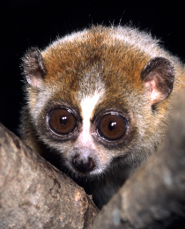 The Pygmy slow loris (Nycticebus pygmaeus) is a rare, large-eyed nocturnal primate. Although, they primarily live in the tropical forests of Vietnam, Laos, Cambodia and China, they can also been found in Vietnam's bamboo thickets and Laos's evergreen forests. The Pygmy slow loris almost became extinct in Vietnam after much of its habitat was destroyed by war. Today, deforestation is still a major threat to this species, and it is currently listed as vulnerable on the International Union for Conservation of Nature's Red List.
The Pygmy slow loris (Nycticebus pygmaeus) is a rare, large-eyed nocturnal primate. Although, they primarily live in the tropical forests of Vietnam, Laos, Cambodia and China, they can also been found in Vietnam's bamboo thickets and Laos's evergreen forests. The Pygmy slow loris almost became extinct in Vietnam after much of its habitat was destroyed by war. Today, deforestation is still a major threat to this species, and it is currently listed as vulnerable on the International Union for Conservation of Nature's Red List.The Pygmy slow loris is a very small primate, growing to only approximately 15 to 25 centimeters (roughly 6 to 10 inches) in length. It typically weighs on average 400 grams or 14 ounces. The loris has a stubby tail, light brown to deep reddish brown fur, white markings on its face, as well as a gray or white underside. This primate also has large, forward facing eyes that help it to see at night.
Lorises are nocturnal omnivores. They enjoy dining on a wide selection of food, including floral nectar, tree gum or sap, plants, fruits, small mammals and insects. These creatures have strong hands and feet that allow them to grip branches very tightly.
The Pygmy slow loris is a mostly solitary creature. They typically only come together during their mating season, although they have occasionally been found sleeping together in small groups. When asleep, the loris will curl up in a tight ball, while still clinging to a branch.
Though lorises are cute, resembling tiny teddy bears, they are one of the few mammals capable of producing a toxin. When frightened, these small primates have been known to lick the area under their arms where the toxin is produced, so that if it bites something, the poison will get into the wound. Though the toxin is not known to be fatal to humans, it may cause painful swelling. In addition, one woman who was bitten was reported to have gone into anaphylactic shock.
Picture of the pygmy slow loris by David Haring / Duke Lemur Center, licensed under Creative Commons Attribution-Share Alike 3.0 Unported license.
Keywords: nocturnal
Which zoos have them?
Minnesota Zoo (United States)The Lesser slow loris, pygmy loris, pygmy slow loris is listed as Vulnerable (VU), considered to be facing a high risk of extinction in the wild, on the IUCN Red List of Threatened Species
Some facts about the
Pygmy loris
Adult weight : 0.419 kg (0.9218 lbs)
Maximum longevity : 17 years
Female maturity :273 days
Gestation : 188 days
Weaning : 133 days
Litter size : 2
Interval between litters : 448 days
Weight at birth : 0.023 kg (0.0506 lbs)

Custom Search